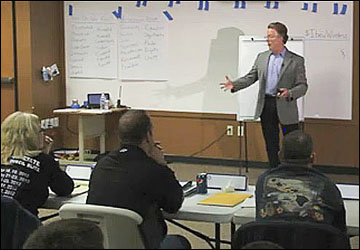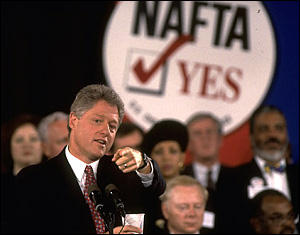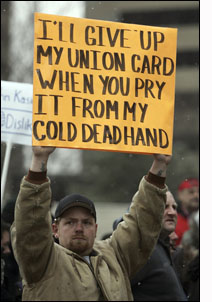OPINION
The Democratic Party is losing the working class
Understanding why is the key to rebuilding a populist progressive movement
By MARK McDERMOTT
(Jan. 10, 2017) — In 2008, Barack Obama was elected along with large Democratic majorities in Congress. Eight years later we have Donald Trump and Republican control of Congress. The Democrats have lost 935 state legislative seats since 2008, and 26 states are under complete control of the Republicans. It is hard putting a happy face on this disaster for Democrats.
 Understanding this multi-year catastrophe is critical to our movement’s organizing an effective long-term strategy anchored in a positive vision to reclaim our country and build a more just, equitable and sustainable future. We must be self-critical and not merely blame the Kochs, Trump and the Republicans. There are many factors for this disaster and I want to focus on three critical factors centered on the Democratic Party:
Understanding this multi-year catastrophe is critical to our movement’s organizing an effective long-term strategy anchored in a positive vision to reclaim our country and build a more just, equitable and sustainable future. We must be self-critical and not merely blame the Kochs, Trump and the Republicans. There are many factors for this disaster and I want to focus on three critical factors centered on the Democratic Party:
1. The enormous loss of support for Democrats among households making less than $50,000 per year;
2. Major loss of support among union members particularly in the Rust Belt; and
3. The long-term support of both Clintons and Obama for “free trade” and largely ignoring its impacts and the long-term crisis of deindustrialization in the Rust Belt.
Over the past four years, I have presented my economic justice and labor education work 16 times in Pennsylvania, Ohio, Michigan, Wisconsin and upstate New York, as well as campaigning in western Pennsylvania for 16 days before the election. (See “Doorbelling at the scene of corporate crimes” — The Stand, Nov. 4, 2016.)
 I have visited many cities, large, medium and small, that have been devastated by plant closures, massive permanent job losses and jobs moving to foreign countries. The intergenerational character of many tight-knit communities has been severely weakened as their younger people leave and permanent hard times remain in many of these hard-hit communities.
I have visited many cities, large, medium and small, that have been devastated by plant closures, massive permanent job losses and jobs moving to foreign countries. The intergenerational character of many tight-knit communities has been severely weakened as their younger people leave and permanent hard times remain in many of these hard-hit communities.
The white working class was hit hard, but the black working class was hit even harder. If you doubt this, visit the many devastated black neighborhoods in Detroit, Flint, Cleveland, Toledo, and Pittsburgh. There is a deep anger about this long-term decline and it erupted last month.
On Nov. 8, the American people were stunned by the election results. Questions of what happened abound. A Reuters exit poll offers important insights into voters’ attitudes:
► 75% agree “America needs a strong leader to take the country back from the rich and powerful.”
► 72% agree: “The American economy is rigged to the advantage of the rich and powerful.”
► 68% agree: “Traditional parties and politicians don’t care about people like me.”
 This election is extraordinary as 60% of voters in exit polls disapproved of Trump and 55% disapproved of Clinton. What a choice! 18% of voters disapproved of both. These voters then gave Trump a 17% margin.
This election is extraordinary as 60% of voters in exit polls disapproved of Trump and 55% disapproved of Clinton. What a choice! 18% of voters disapproved of both. These voters then gave Trump a 17% margin.
Tens of millions were holding their noses when voting.
Clinton won the popular vote by 2.8 million. However, she lost by 3.1 million if California and New York are excluded.
We don’t have a national election, we have 50 state elections. A one-vote margin in a state is as good as a 1 million vote margin in deciding the Electoral College vote. Narrow victories in Pennsylvania, Michigan and Wisconsin elected Donald Trump.
I offer a partial explanation of what happened.
In 2008, Barack Obama crushed John McCain in Michigan (16% margin), Wisconsin (14%), and Pennsylvania (10%). Total margin: 1.7 million in these states. In 2012, he won all three again but by much smaller margins. Total Obama margin: 1.07 million. Democratic presidential candidates had won Wisconsin every election since 1988 and Michigan and Pennsylvania since 1992.
In 2016, Trump won all three states by 77,000 votes, a 1.8 million vote swing in 8 years. What accounts for this dramatic shift? It started long before alleged Russian hacking, FBI Director James Comey’s intervention, Clinton’s poor campaign strategy, aggressive voter suppression, and Trump’s vile bigotry.
 In 1993, Bill Clinton with Hillary at his side and Congressional Democrats enacted the North American Free Trade Agreement (NAFTA) over the strong opposition of organized labor. NAFTA’s hollow promises helped devastate these states with massive job losses. In the 2008 election, Obama promised to re-negotiate NAFTA. Once elected, Obama’s promise disappeared. He then began pushing the Trans-Pacific Partnership (TPP), another free trade deal, all through the 2016 election. Hillary was in favor of NAFTA and the TPP for many years until she finally decided to oppose the TPP. In sharp contrast, Trump hammered NAFTA, the TPP and free trade across these key hard-hit states for many months.
In 1993, Bill Clinton with Hillary at his side and Congressional Democrats enacted the North American Free Trade Agreement (NAFTA) over the strong opposition of organized labor. NAFTA’s hollow promises helped devastate these states with massive job losses. In the 2008 election, Obama promised to re-negotiate NAFTA. Once elected, Obama’s promise disappeared. He then began pushing the Trans-Pacific Partnership (TPP), another free trade deal, all through the 2016 election. Hillary was in favor of NAFTA and the TPP for many years until she finally decided to oppose the TPP. In sharp contrast, Trump hammered NAFTA, the TPP and free trade across these key hard-hit states for many months.
Working class people were listening and noticed who would come to their communities and talk about these issues. Clinton never campaigned in Wisconsin and barely campaigned in Michigan after losing their primaries, and was almost completely absent in most of Pennsylvania. Meanwhile, Trump toured these states. For decades, struggling working class families and communities in these states have longed for a national champion to fight hard on this issue and related job losses. A racist, sexist Republican demagogue emerged as their champion. This was a recipe for disaster.
In 2008 and 2012, Obama won voters nationally in households earning less than $50,000 per year 60-38%. In 2016, Clinton won 53-40%. If she had won 60-38%, she would pick up an additional 3.2 million votes. Among these households in Pennsylvania, Obama won by 36% in 2012, Clinton by 12%. In Wisconsin, Obama by 25%, Clinton 2%. In Michigan, Obama by 26%; Clinton 11%.
These dramatic shifts doomed Clinton.
 A disastrous shift in voters in union households also doomed Clinton. In 2008, voters in union households gave Obama a 20% victory; and in 2012 18%. Clinton only won by 9% in 2016. If Clinton won by 18%, she picks up 1.3 million votes. Consider the following: Obama won union households in Michigan in 2012 by 33%; Clinton by 13% in 2016. In Ohio, Obama won by 23% in 2012; Clinton lost by 9%.
A disastrous shift in voters in union households also doomed Clinton. In 2008, voters in union households gave Obama a 20% victory; and in 2012 18%. Clinton only won by 9% in 2016. If Clinton won by 18%, she picks up 1.3 million votes. Consider the following: Obama won union households in Michigan in 2012 by 33%; Clinton by 13% in 2016. In Ohio, Obama won by 23% in 2012; Clinton lost by 9%.
There can be no doubt that these dramatic shifts nationally among low-wage working-class voters and voters in union households doomed Clinton and many Democratic congressional candidates. These shifts were extraordinarily large in these three battleground states. Given the extremely narrow margins of defeats in these three states, there are other factors that can potentially explain those defeats but I don’t believe they explain these larger shifts among lower wage workers and their families and union households away from the Democrats.
Voter suppression undoubtedly played a role in the election results. There were significant declines in victory margins between 2012 Obama and 2016 Clinton in heavily black cities and counties like Wayne County (Detroit), Michigan, Milwaukee, and Philadelphia. These declines were critical to Clinton’s defeat. How much is voter suppression and how much was lack of enthusiasm for Clinton? I don’t know but I will keep looking for clearer answers. If you have solid evidence about this issue, please send it my way.
 Trump’s appeals to racism, sexism, anti-immigrant bashing and much more played a role in this election. Clearly, they are morally repugnant, damaging to our country and harmful, to so many of our sisters and brothers in our diverse communities. As I stated earlier, I offer a partial explanation to what happened. Some of the data puzzles me and keeps me searching for answers. Consider the following: Despite all the racist immigrant bashing, the exit polls show that the percentage of people in the U.S. who support a pathway to citizenship for undocumented immigrants rose from 65% in 2012 to 70% in 2016.
Trump’s appeals to racism, sexism, anti-immigrant bashing and much more played a role in this election. Clearly, they are morally repugnant, damaging to our country and harmful, to so many of our sisters and brothers in our diverse communities. As I stated earlier, I offer a partial explanation to what happened. Some of the data puzzles me and keeps me searching for answers. Consider the following: Despite all the racist immigrant bashing, the exit polls show that the percentage of people in the U.S. who support a pathway to citizenship for undocumented immigrants rose from 65% in 2012 to 70% in 2016.
I am delighted by this growing support but I can’t explain it.
In closing, it is critical to understand this catastrophic defeat and learn from it. We will all pay a price in the years ahead. As we move into the new year, I say, “Don’t agonize, organize,” and “Fight forward and not just fight back.”
This is our country. We have a great opportunity in the next four years. The American people want change. We must listen more carefully to them and offer a clear vision of a positive future as we fight forward. It is critical for us to reach across our great divides: race, gender, sexual orientation, union vs. non-union, urban vs. rural, native born and foreign born, age, class and regions of our states and country. We must listen to and learn from each other, find our common ground and never, ever give up the fight for a better country and world. Our children and grandchildren and those we love are counting on us.
 Mark McDermott is an economic justice educator and writer who has been a political activist for many years working on economic, racial and social justice. For more information, visit markmmcdermott.com or his Facebook page, or email Mark.
Mark McDermott is an economic justice educator and writer who has been a political activist for many years working on economic, racial and social justice. For more information, visit markmmcdermott.com or his Facebook page, or email Mark.





